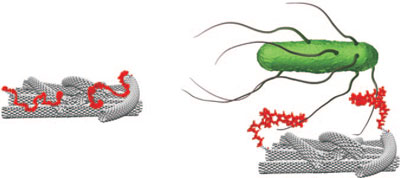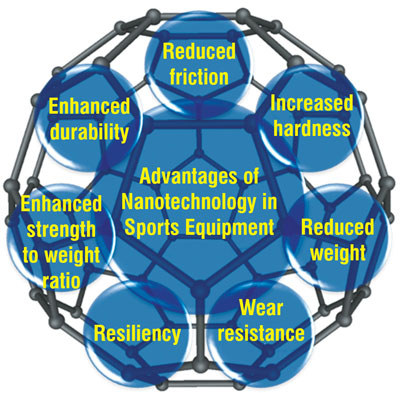Nanotechnology Examples and Applications
Background – what makes nanotechnology special
One of the most fascinating aspects of nanotechnology is the incredibly small scale at which nanoengineering and nanofabrication take place. Consider this example: The first working transistor, built by Bell Labs John Bardeen, Walter Brattain, and William Shockley in 1947, measured roughly 1 centimeter across. Today, logic transistor density has surpassed a staggering 100 million transistors per square millimeter. That means that the same surface area of Bell Labs' original transistor can now contain more than 10 billion transistors!
Chemists and biologists have dealt with naturally occurring nanoparticles all along. Think molecules or viruses. Toxicologists have dealt with nanoparticles that are the result of modern human life such as carbon particles in combustion engine exhaust. Without being aware of it, tire manufacturers used nanoparticles (carbon black) to improve the performance of tires as early as the 1920s. Medieval artists used (unknowingly) gold nanoparticles to achieve the bright red colors in church windows. You might even say that we are surrounded by, and made of, nanomaterials – atoms and molecules are nanoscale objects after all. So why all the fuzz about nano now?
The ongoing quest for miniaturization has resulted in tools like the atomic force microscope and the scanning tunneling microscope. Combined with refined processes such as electron beam lithography, these instruments allow researchers to deliberately manipulate and manufacture nanostructures; something they couldnt do before.
Engineered nanomaterials, either by way of a top-down approach (a bulk material is reduced in size to nanoscale patterns) or a bottom-up approach (larger structures are built or grown atom by atom or molecule by molecule), go beyond just a further step in miniaturization. They have broken a size barrier below which quantization of energy for the electrons in solids becomes relevant.
The so-called quantum size effect describes the physics of electron properties in solids with great reductions in particle size. This effect does not come into play by going from macro to micro dimensions. However, it becomes dominant when the lower nanometer size range is reached. Materials reduced to the nanoscale can suddenly show very different properties compared to what they show on a macroscale. For instance, opaque substances become transparent (copper); inert materials become catalysts (platinum); stable materials turn combustible (aluminum); solids turn into liquids at room temperature (gold); insulators become conductors (silicon).
A second important aspect of the nanoscale is that the smaller a nanoparticle gets, the larger its relative surface area becomes. Its electronic structure changes dramatically. Both effects lead to greatly improved catalytic activity but can also lead to aggressive chemical reactivity.
The fascinating prospects that nanotechnology offers engineers and researchers stems from these unique quantum and surface phenomena that matter exhibits at the nanoscale, making possible novel materials and revolutionary applications.
It is quite amazing how much of nanotechnology-related research is inspired by nature's designs. As a matter of fact, nature is full of examples of sophisticated nanoscopic architectural feats. Whether it is structural colors; adhesion; porous strength; or bacterial navigation and locomotionthey underpin the essential functions of a variety of life forms, from bacteria to berries, wasps to whales.
Examples of nanotechnology products and applications
Nanobiotechnology is the application of nanotechnologies in biological fields. Chemists, physicists and biologists each view nanotechnology as a branch of their own subject, and collaborations in which they each contribute equally are common. One result is the hybrid field of nanobiotechnology that uses biological starting materials, biological design principles or has biological or medical applications.
While biotechnology deals with metabolic and other physiological processes of biological subjects including microorganisms, in combination with nanotechnology, nanobiotechnology can play a vital role in developing and implementing many useful tools in the study of life. Although the integration of nanomaterials with biology has led to the development of diagnostic devices, contrast agents, analytical tools, therapy, and drug-delivery vehicles, bionanotechnology research is still in its infancy.

The term nanoelectronics refers to the use of nanotechnology in electronic components. These components are often only a few nanometers in size. However, the tinier electronic components become, the harder they are to manufacture.
Nanoelectronics covers a diverse set of devices and materials, with the common characteristic that they are so small that physical effects alter the materials'properties on a nanoscale inter-atomic interactions and quantum mechanical properties play a significant role in the workings of these devices. At the nanoscale, new phenomena take precedence over those that hold sway in the macro-world. Quantum effects such as tunneling and atomistic disorder dominate the characteristics of these nanoscale devices.
The term nanocoating refers to nanoscale (i.e. with a thickness of a few tens to a few hundreds of nanometers) thin-films that are applied to surfaces in order create or improve a material's functionalities such as corrosion protection, water and ice protection, friction reduction, antifouling and antibacterial properties, self-cleaning, heat and radiation resistance, and thermal management.
Nanocoatings offer significant benefits for applications in the aerospace, defense, medical, marine, and oil industries, have driven manufacturers to incorporate multi-functional coatings in their products.
A major area for non-stick nanocoatings is in the comsumer industry. Ever got frustrated by the amount of ketchup left in the bottle? No more! Nanocoatings leave no waste behind:
Nanoplasmonics research focuses on the optical phenomena in the nanoscale vicinity of metal surfaces. In nanoplasmonics, researchers focus nanoscale light below the diffraction limit (which typically is half the width of the wavelength of light being used to view the specimen) by converting free photons into localized charge-density oscillations – so-called surface plasmons – on noble-metal nanostructures, which serve as nanoscale analogs of radio antennas and are typically designed by using antenna theory concepts.
The term nanosensor is not clearly defined. Most definitions refer to a sensing device with at least one of its dimensions being smaller than 100 nm and for the purpose of collecting information on the nanoscale and transferring it into data for analysis.
Nanosensors are not necessarily reduced in size to the nanoscale, but could be larger devices that make use of the unique properties of nanomaterials to detect and measure events at the nanoscale. For instance, in noble metals such as silver or gold, nanostructures of smaller size than the de Broglie wavelength for electrons lead to an intense absorption in the visible/near-UV region that is absent in the spectrum of the bulk material.
Nanosensors have been developed for the detection of gases, chemical and biochemical variables, as well as physical variables and the detection electromagnetic radiation.
If you ever have wondered where nanotechnology will take us, look no further than the potential applications in the area of functional food by engineering biological molecules toward functions very different from those they have in nature, opening up a whole new area of research and development. Of course, there seems to be no limit to what food technologists are prepared to do to our food and nanotechnology will give them a whole new set of tools to go to new extremes.
Nanotechnology offers the opportunity for alternative sensor platforms for the rapid, sensitive, reliable and simple isolation and detection of E. coli and other pathogens. Nanotechnology enabled detection techniques include detections by luminescence using quantum dots; localized surface plasmon resonance of metallic nanoparticles; enhanced fluorescence; dye immobilized nanoparticles; or Raman reporter molecule immobilized metallic nanoparticles.

Nanotechnologies provide the potential to enhance energy efficiency across all branches of industry and to economically leverage renewable energy production through new technological solutions and optimized production technologies. Nanotechnology innovations could impact each part of the value-added chain in the energy sector: Energy sources; energy conversion; energy distribution; energy storage; and energy usage.
Graphene has proven useful for different types of batteries redox flow, metalair, lithiumsulfur, lithium-metal and, more importantly, lithium-ion batteries. Since graphene can be chemically processed into various forms suitable for both the positive and negative electrodes, this enables the fabrication of all-graphene batteries with ultrahigh energy density.
In the near future, using nanomaterials in furniture may lead to a reduced need for adhesives and functional textiles. Expect to see "smart" furniture furniture that heats itself when it's cold; becomes opaque when the sun is shining intensely; changes color upon demand; measures core body functions; has antibacterial coatings that get activated on contact or self-healing coatings to repair scratches and minor damage; has embedded electronics that for instance signals you when you run out of food supplies; or includes shape memory alloys that change their shape.
Nanotechnology will play an important role in future space missions. Nanosensors, dramatically improved high-performance materials, or highly efficient propulsion systems are but a few examples.
The applications of nanotechnology and nanomaterials can be found in many cosmetic products including moisturisers, hair care products, make up and sunscreen.
The automotive sector is a major consumer of material technologies and nanotechnologies promise to improve the performance of existing technologies significantly. Applications range from already existing paint quality, fuel cells, batteries, wear-resistant tires, lighter but stronger materials, ultra-thin anti-glare layers for windows and mirrors to the futuristic energy-harvesting bodywork, fully self-repairing paint, switchable colors, shape-shifting skin.
Nanoengineering of cement-based materials can result in outstanding or smart properties. Introduction of nanotechnology in the cement industry has the potential to address some of the challenges such as CO2 emissions, poor crack resistance, long curing time, low tensile strength, high water absorption, low ductility and many other mechanical performances.
The video below shows how researchers are using nanosilica to strengthen concrete:
Nanotechnology has a significant impact in the construction sector. Several applications have been developed for this specific sector to improve the durability and enhanced performance of construction components, energy efficiency and safety of the buildings, facilitating the ease of maintenance and to provide increased living comfort.
Display technologies can be grouped into three broad technology areas; Organic LEDs, electronic paper and other devices intended to show still images, and Field Emission Displays. Nanomaterials and nanofabrication techniques play a role in all of them.
Nanomedicine is
1) the comprehensive monitoring, control, construction, repair, defense, and improvement of all human biological systems, working from the molecular level, using engineered nanodevices and nanostructures;
2) the science and technology of diagnosing, treating, and preventing disease and traumatic injury, of relieving pain, and of preserving and improving human health, using molecular tools and molecular knowledge of the human body;
3) the employment of molecular machine systems to address medical problems, using molecular knowledge to maintain and improve human health at the molecular scale.
Nanotechnological products, processes and applications are expected to contribute significantly to environmental and climate protection by saving raw materials, energy and water as well as by reducing greenhouse gases and hazardous wastes. Using nanomaterials therefore promises certain environmental benefits and sustainability effects.
Within the niche of sport equipments, nanotechnology offers a number of advantages and immense potential to improve sporting equipments making athletes safer, comfortble and more agile than ever. Baseball bats, tennis and badminton racquets, hockey sticks, racing bicycles, golf balls/clubs, skis, fly-fishing rods, archery arrows, etc. are some of the sporting equipments, whose performance and durability are being improved with the help of nanotechnology.

Nanotechnology advantages in sports equipment. (Image: Wikimedia Commons)
We have also compiled a Nanotechnology FAQ – Frequently Asked Questions list for you to explore.
